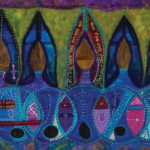J-students go hyperlocal with smartphones
 “If we want to tell and share our stories,” writes Wayne MacPhail, “we should learn to use and master the devices more and more people are using to consume and create. If you want to explore community-level hyperlocal journalism, smartphones are a natural tool for a diffuse, mobile news team.”
“If we want to tell and share our stories,” writes Wayne MacPhail, “we should learn to use and master the devices more and more people are using to consume and create. If you want to explore community-level hyperlocal journalism, smartphones are a natural tool for a diffuse, mobile news team.”
 Armed with smartphones to research, interview and write, Wayne MacPhail’s j-students tackle street-level journalism while learning to file from the field.
Armed with smartphones to research, interview and write, Wayne MacPhail’s j-students tackle street-level journalism while learning to file from the field.
On a cold fall night about 20 years ago I was standing in a phone booth along side the Welland Canal. The deck of the lake freighter I was writing about was slowly sinking down as the lock level lowered. In front of me was a Radio Shack TRS-80 Model 100 computer with a faint 8-line LCD display. It was acoustically coupled to the grimey pay phone’s handset and was sputtering my copy at 300 characters per second back to my newsroom. It spurted the last period of my story in time for me to leap down to the descending, ice-rimmed deck and continue my journey.
Now, two decades later, I want my students to have the same experience. I want them to witness and then file from the scene, but I want them to use smartphones connected to a high speed, 3G network. And I want those phones to be capable of capturing video and stills, creating text and sharing.
Okay, I don’t expect them to back a pig-slow file transfer in a race against a departing lake freighter. But the idea remains the same.
This semester, thanks to help from Telus and Motorola (Telus provided data plans for the 25 phones Motorola provided) my fellow third-year online journalism instructor Vinita Srivastava and I have been able to provide all our two dozen students at Ryerson University with Android-powered smartphones (Milestones, aka Droids in the U.S.), which are theirs to use for the duration of the course.
While some of the students already have feature phones and BlackBerries (and a very few, iPhones), it’s great to have them all at the same level and give them equal and free access to a technology that can get pretty pricey when you factor in a monthly data plan.
Our intention is to have the students, where possible and appropriate, do as many aspects of their reporting on the phones as possible. That includes research, using social media, recording audio, capturing video, taking still photos, writing and editing stories and filing online to flickr, YouTube, our class blog and the Toronto-based hyperlocal news site, openfile.ca.
We are working with openfile.ca because they have created a very interesting model for hyperlocal news.
They fully engage communities in their own coverage and encourage non-journalists to open files on the site on issues or events that they are curious about. Site editors then assign freelance journalists to follow up on the leads and produce stories for the site. Those stories can be followed up by anyone and leave an online comet trail of evidence and additions in their wake.
While the municipal election was going on in Toronto, the students used their smartphones to bring citywide election issues down to the neighbourhood level. They also live-tweeted candidate meetings and, on election night, results and reactions. They’ve already used them to capture and share video interviews with candidates, share photo essays of wards, write their stories in coffee shops and even catch breaking news in the form of a dramatic fire in a Wellsley Avenue apartment that led to the evacuation of hundreds of residents. Some of those residents were interviewed via smartphone video.
All well and good, but why is using smartphones important?
First, because mobile devices like smartphones are not only perfect little tools for journalism, but, equally as important, more and more people are using these devices to not only consume content but also to create and distribute photos, gossip, events and the other little flakes of experience that are taken for news by those that care deeply about them.
So, if we want to tell and share our stories, we should learn to use and master the devices more and more people are using to consume and create.
Second, if you want to explore community-level hyperlocal journalism, smartphones are a natural tool for a diffuse, mobile news team.
Third, smartphones are powerful multimedia tools capable of capturing broadcast quality audio and video, but they are also light, unobtrusive and non-threatening for folks not used to media attention.
Fourth, these devices are built for social networks, online sharing and diffuse content creation. If you want to teach the journalistic application of these things, they are ideal.
Finally, they help us model the future. These devices will only get faster, smarter and more capable (and probably thinner). Networks will get faster and ubiquitous. Devices like tablets and smartphones will be our go-to devices for consuming news. We should help our students get used to it.
There’s one other aspect of this experiment I should mention. The students post final stories to openfile.ca but also collectively contribute notes on their progress and process to our shared blog, Rye Here, Rye Now, which is built on the posterous.com microblogging platform. Students contribute text, video, photos or photo slideshows from their phones just by emailing them to posterous.
That combination gives students an on-the-ground tool for news capture and an near-instant place to post it. We want to make mobile news coverage gestural. We’ll let you know how that turns out.
Wayne
MacPhail began in the industry as a magazine photographer, feature
writer and editor. In 1983, he moved to the Hamilton Spectator where was
a health, science and social services columnist, feature writer and
editor. In 1991, he founded Southam InfoLab, a research and development
lablooking into future information products for this Canadian national
newspaper chain. After leaving Southam, he developed online content for
most Canadian online networks. Wayne now heads up w8nc inc., helping
non-profit organizations, colleges and universities, charitable
organizations and associations develop and implement technology-based,
marketing driven communications strategies. He also teaches online
journalism at the University of Western Ontario and Ryerson University.
He serves on the board of rabble.ca where he founded the rabble podcast network and rabbletv. He’s a regular tech columnist for the website and for mondoville.com.




